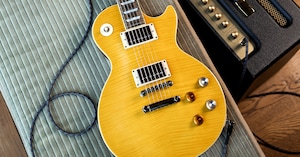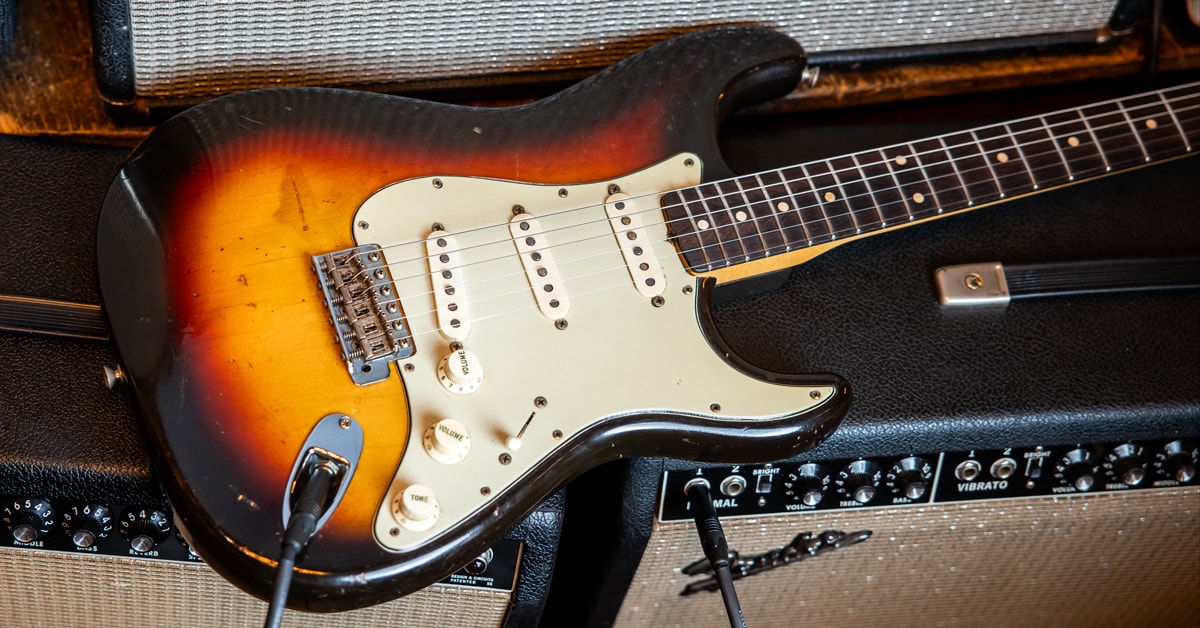The Fender Stratocaster was not meant to be an unalterable monument. It did not spring fully formed from the head of Zeus, as did the mythic goddess Athena.
In the chronicles of guitar, the newborn 1954 Stratocaster was indeed a definitive and groundbreaking instrument, but it wasn’t yet the marvel it ultimately became, and it took almost a decade before the Strat enjoyed its own version of “Beatlemania” (or, Taylor Swiftie-like popularity).
We can blame Leo Fender for the moving target that is the Stratocaster. He was a certified genius, but he was also a tinkerer. Without apology, Fender was an engineer driven to seek the next improvement, the next enhancement, the next “better.”
When he designed the Stratocaster to be a “modular” instrument, he wasn’t kidding, because after 70 years of hot-rodding, altering and experimentation, the Stratocaster continues to evolve.
But let’s zip backwards to the cauldron of creativity that defined Fender from 1954 to 1965. For the Stratocaster, this was an era when every refinement was forged by the inventor himself, along with his team.
It was also a moment in time when notable ’50s guitarists and trusted advisers offered real-time input on how to keep improving the earliest Stratocasters. Furthermore, Leo and his crew could absorb the experiences of the marketplace, where players, music stores and other musical instrument companies were first experiencing this newfangled, space-age guitar.
Table of Contents
What Was the Original Stratocaster Recipe in 1954?
A Timeline of Stratocaster Refinements
Stratocaster Specs Year by Year, 1954-1965
What Is the Best Year Ever for the Stratocaster?
Other Excellent Years for the Pre-CBS Stratocaster
Find Vintage Fender Strats at Guitar Center
How Leo Fender Got It Right With the Stratocaster
What Was the Original Stratocaster Recipe in 1954?
As you can read in our History of the Fender Stratocaster, the development of the guitar required a village of driven and impassioned engineers, salespeople and players. The birth was sometimes a messy one, and history is occasionally blurred by recollections of participants laying claim to their roles in suggesting or improving certain elements of the final design.
But we do know the production-model Fender Stratocaster was “officially” unveiled in October 1954. And yet, even that date carries some confusion, as there are reports that the first 200 Stratocasters actually left the factory in spring of 1954. However, Forrest White—Fender’s factory manager at the time—asserted that any 1954 Strats manufactured before October 13, 1954, were likely preproduction or artist models sold directly to players from the factory.
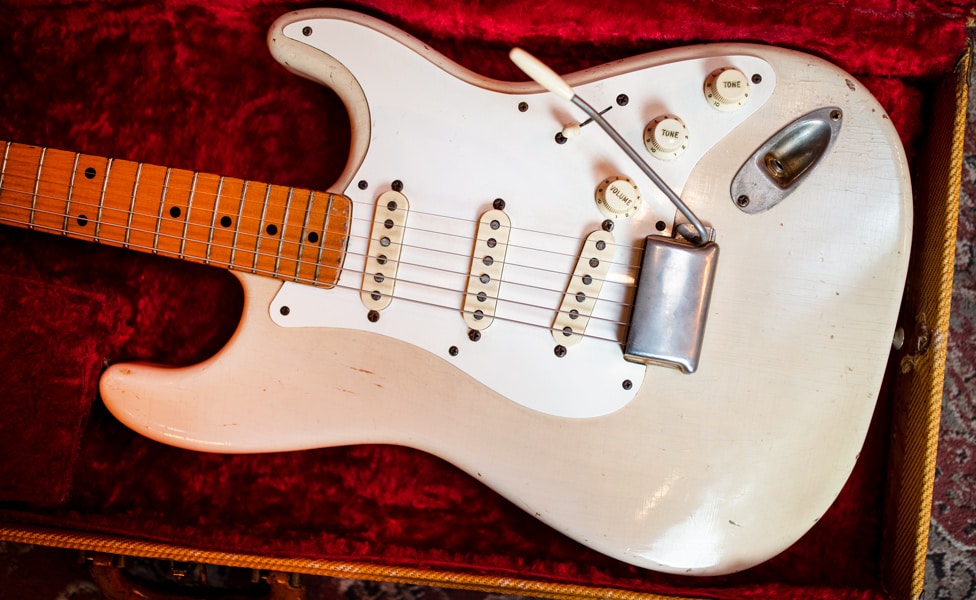
In any case, the 1954 Fender Stratocaster hit the streets at a cost of $249.50 with tremolo ($229.50 without). Now, $249 in 1954 is approximately $2,839 today, so the Strat was a bit of a luxury item in the Eisenhower era. (Fender sales executive Don Randall had, in fact, repeatedly asked Leo for a more upscale guitar that could compete with Gibson’s Les Paul.) Guitarists in 1954 could choose to purchase six new Stratocasters, or opt for the year’s most popular car, a Chevy Bel Air four-door sedan listing for $1,685.
When a player opened the case to marvel at the futuristic Fender guitar 1954 had dropped into his or her orbit, the brand-new Stratocaster featured a two-tone sunburst finish over an ash body, rounded D-shape maple neck, maple fretboard, 25.5" scale length, 7.25" radius, 21 small (.078" wide) frets, three Alnico III single-coil pickups, and the choice of a fixed bridge or Fender synchronized tremolo.
As you can guess at this point, it took a while for the Stratocaster to settle on its debut specifications, and they didn’t stay put as the ’50s and ’60s rambled on.
A Timeline of Stratocaster Refinements
Volumes have been written about the Stratocaster’s development—including books by the original Fender team—and vintage experts have been known to rain hellfire on anyone who mangles even an infinitesimal factoid.
However, as mentioned earlier, even the people who were there tended to have slightly different accounts regarding certain aspects of Stratocaster production—which is to be expected, as the Fender factory was in the process of optimizing its workflow, sourcing parts, balancing features and profitability, and sustaining a commitment to bring something extraordinarily innovative to market.
There was a whole lot of activity going on in the Fender think tank and production floor during the Strat’s journey to the version players could buy at their favorite music store, but we’ve tried to make this timeline “directional” enough to give you a basic idea of what was going down and when. We also chose to focus on features that may have significant tonal, appearance and ergonomic relevance to players, rather than catalog every single engineering upgrade, such as “worm routes” in the pickup cavity and the number of screw threads. Here we go …
March 1954
• The Stratocaster’s sunburst starts out as a “one-burst.” Fender simply painted dark brown around the natural ash of the body.
• Super contoured body.
• Initial tremolo prototypes had three springs instead of five.
• Volume and Tone potentiometers are 100k with a solid brass shaft.
May/June 1954
• A real two-color sunburst makes the scene—canary yellow to amber brown.
• Volume and Tone pots are now 250k, although still solid brass. (The thinking may have been that 100k pots were too dark sounding.)
• One-piece maple neck gets a walnut stripe where the truss rod was inserted.
• Neck shape is a stocky rounded D.
• Four-bolt neck attachment.
• Pickguard is a single layer of .060" thick ABS plastic with eight attachment screws.
• Pickup covers and control knobs are white Bakelite (polystyrene thermoplastic).
• Tremolo bar has exaggerated bends.
October 1954
• Production-model chapter begins. Stratocasters are now more assembly-line constructed and consistent.
• Volume and Tone pots switch to split shaft, due to the Strat’s knobs being a press-on style, as opposed to Telecaster knobs of the time that required a solid shaft to accommodate a set screw.
1955
• Headstock edges become sharper and less rounded.
• The bends in the tremolo bar aren’t as severe.
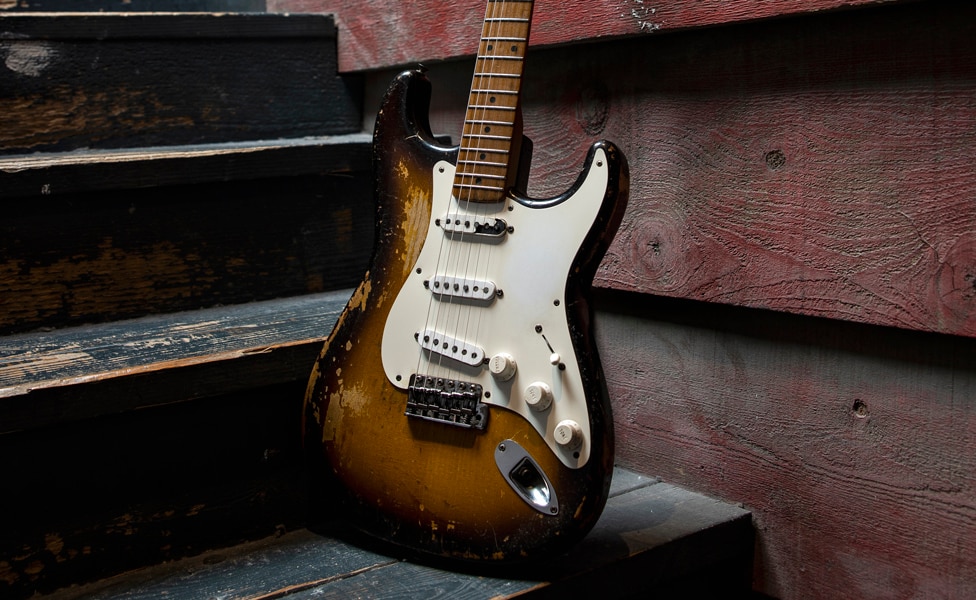
1956
• Alder replaces ash as body wood—excepting blond models. Fender’s website explains the change as “probably for no other reason than it was there—readily available and more affordable than ash.” On the tone front, however, alder does exhibit an increased upper-midrange emphasis as compared to the bright presence and balanced warmth of ash.
• Neck shape is now a soft V.
• Tremolo bar bends get even less pronounced.
1957
• ABS plastic replaces Bakelite for knobs and pickup covers.
• Neck shape changed to strong V. (Note: Eric Clapton’s famous “Blackie” Strat had a 1957 neck.)
1958
• Sunburst is now three colors—yellow to red to dark brown.
• Neck becomes a thinner D shape.
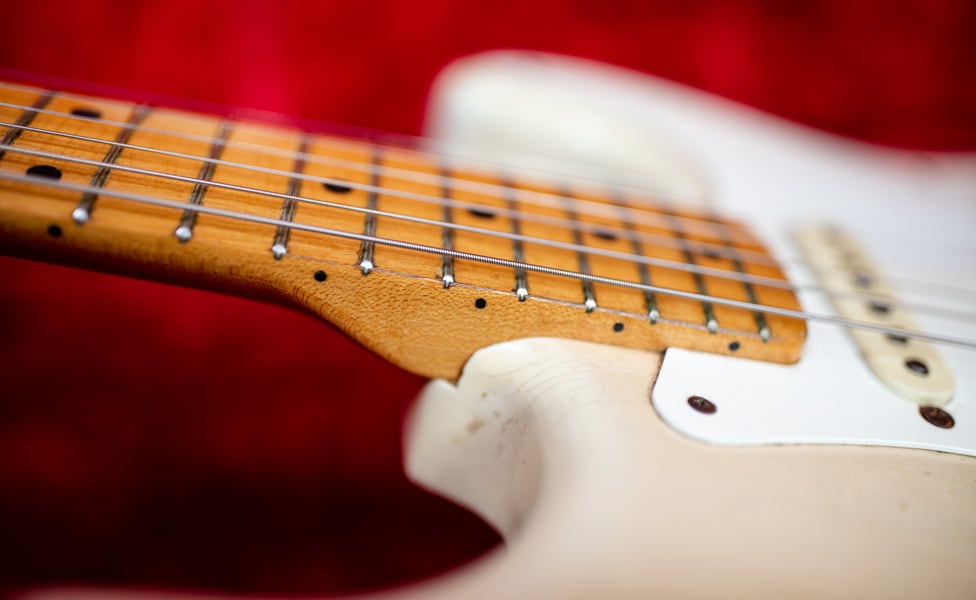
1959
• Maple fretboards replaced with slab rosewood. Neck construction is now two-piece, rather than one-piece. (Note: The change may have been made to give the Strat a classier look. From a tonal standpoint, maple is generally typified as having a punchy, articulate timbre, while rosewood can sound dark and warm.)
• Pickguard changed to three-layer celluloid (white/black/white) with 11 attachment screws. Color is mint green.
• Neck begins to thin and gets thinner as the months pass.
1960
• No notable changes.
1961
• To minimize fading, a very robust red is added to the sunburst finish.
• The amber brown component of the sunburst is changed to black.
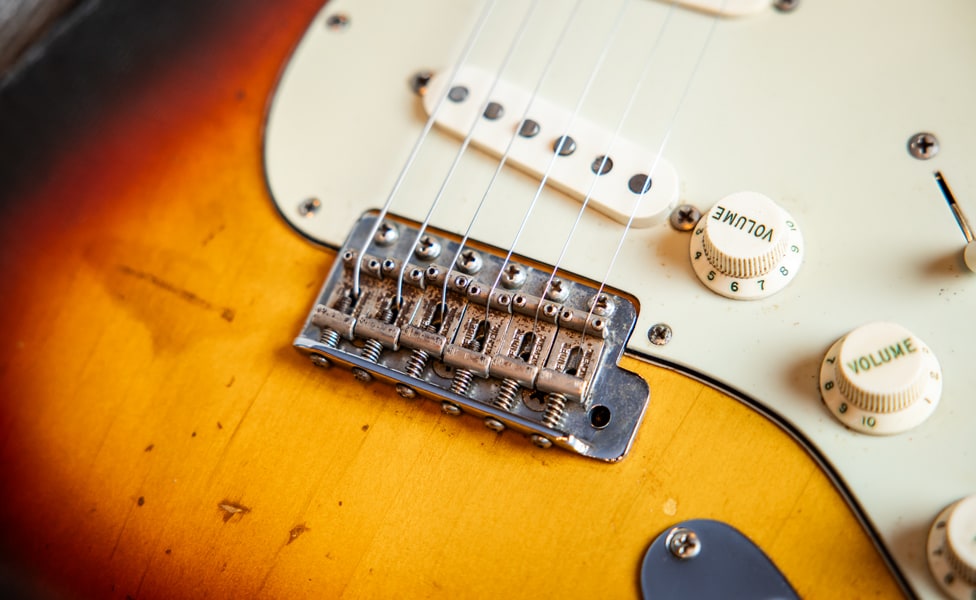
1962
• Around August 1962, the slab rosewood fretboard is changed to a thin, round-laminate rosewood veneer. (Note: Assumptions about the tonal impact of the change are challenging, as Fender was also playing with neck shapes and the pickups began to get more windings on the coil—hence, a fatter sound.)
1963
• Body contours become slightly less dramatic.
1964
• Three-color sunburst looks more like a “target” with decreased blending between colors.
• Pickguard is now white, three-layer plastic, replacing mint green.
• Body contouring diminishes further—especially at right forearm.
1965
• Headstock is enlarged in December to allow for a bigger Fender decal.
• Maple fretboards offered as an option.
Stratocaster Specs Year by Year, 1954-1965
Here’s another view of Stratocaster development—as if you were scanning the main specs on one of Guitar Center’s online product pages. (But, of course, imagining you could do that in the ’50s and ’60s before the internet.) You can see that many elements stayed pretty much the same, with perhaps the main action going on with neck shapes, as Fender strove to deliver more and more player comfort. It’s also of interest that the frets were really tiny and narrow. Many modern-day players might have found the micro-sized frets to be somewhat challenging, but they obviously worked just fine for ’50s and ’60s musical styles and techniques.
|
Year |
Body |
Standard Finishes |
Neck |
Neck Shape |
Fretboard |
Scale |
Radius |
Frets |
Pickups
|
|
1954 |
Ash |
Two-tone sunburst |
Maple |
Rounded D |
Maple |
25.5" |
7.25" |
21 small (.078") |
Alnico III single coil |
|
1955 |
Ash |
Two-tone sunburst |
Maple |
Rounded D |
Maple |
25.5" |
7.25" |
21 small (.078") |
Alnico III single coil |
|
1956 |
Alder |
Two-tone sunburst; any DuPont Duco color for 5% upcharge |
Maple |
Soft V |
Maple |
25.5" |
7.25" |
21 small (.078") |
Alnico V single coil |
|
1957 |
Alder |
Two-tone sunburst; any DuPont Duco color for 5% upcharge |
Maple |
V |
Maple |
25.5" |
7.25" |
21 small (.078") |
Alnico V single coil |
|
1958 |
Alder |
Three-tone sunburst; custom colors or blonde for 5% upcharge |
Maple |
Slim C |
Maple |
25.5" |
7.25" |
21 small (.078") |
Alnico V single coil |
|
1959 |
Alder |
Three-tone sunburst; custom colors or blonde for 5% upcharge |
Maple |
Slim C |
Rosewood (slab) |
25.5" |
7.25" |
21 small (.078") |
Alnico V single coil |
|
1960 |
Alder |
Three-tone sunburst; 14 custom colors offered for 5% upcharge |
Maple |
Slim C |
Rosewood (slab) |
25.5" |
7.25" |
21 small (.078") |
Alnico V single coil |
|
1961 |
Alder |
Three-tone sunburst; 14 custom colors offered for 5% upcharge |
Maple |
Slim C |
Rosewood (slab) |
25.5" |
7.25" |
21 small (.078") |
Alnico V single coil |
|
1962 |
Alder |
Three-tone sunburst; 14 custom colors offered for 5% upcharge |
Maple |
Slim C |
Rosewood (veneer) |
25.5" |
7.25" |
21 small (.078") |
Alnico V single coil |
|
1963 |
Alder |
Three-tone sunburst; 14 custom colors offered for 5% upcharge |
Maple |
Oval C |
Rosewood (veneer) |
25.5" |
7.25" |
21 small (.078") |
Alnico V single coil |
|
1964 |
Alder |
Three-tone sunburst; 14 custom colors offered for 5% upcharge |
Maple |
Oval C |
Rosewood (veneer) |
25.5" |
7.25" |
21 small (.078") |
Alnico V single coil |
|
1965 |
Alder |
Three-tone sunburst; 14 custom colors offered for 5% upcharge |
Maple |
Oval C |
Rosewood or maple |
25.5" |
7.25" |
21 small (.078") |
Alnico V single coil |
What Is the Best Year Ever for the Stratocaster?
We can cut to the chase here. Many historians, collectors and players in the know consider 1962 to be the greatest year for the Stratocaster. The alder body and maple neck with a thin, rosewood-veneer fretboard, deliver the sonic sweet spot for Strat aficionados.
In addition, we can assume the basic Stratocaster formula had settled in by 1962, making it easier for the assembly-line workers to produce more consistent guitars and better overall quality.
But let’s throw a wrench into the works.
What production dates in 1962—and which instruments of 1962—are stunning examples of the Stratocaster’s vintage majesty? And how is it that two seemingly identical 1962 Stratocasters can present with one sounding and playing absolutely glorious, and the other exhibiting “just average” tones and playability?
Yes. Things can get a bit fuzzy. Here’s why …
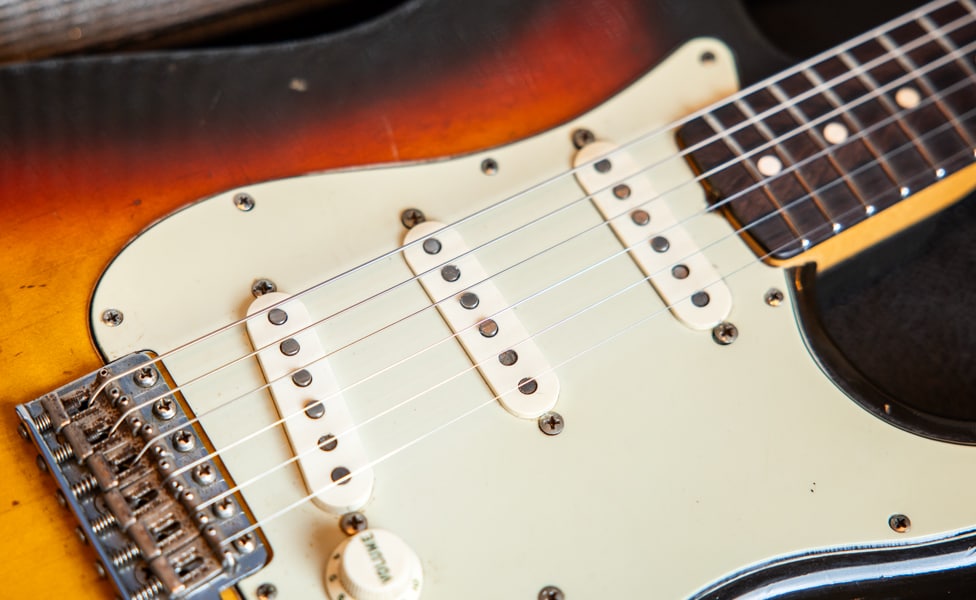
• Manufacturing by humans can be erratic. Humans are not CNC (Computer Numerical Control) machines. While a CNC system was used to fashion helicopter blades in 1949, the use of this expensive machinery was certainly not widespread until much later—especially for guitar manufacturing. So, an employee winding pickups with a hangover, or looking too forward to the weekend on a Friday, or having a brain glitch while fashioning a 7.25" radius on a neck (and turning it in as a 6.75" or 7.75" radius) can significantly “amend” the feel of a 1962-spec Stratocaster. Today, we are accustomed to—and expect—consistent manufacturing tolerances. In 1962, you sometimes dealt with variances.
• Parts. Forrest White is credited with transforming the early Fender factory into a truly professional and operational plant. But White still had his challenges with inventories, less-than-sophisticated tooling and changing parts to accommodate design refinements in the mid 1950s and early 1960s. The result is that all 1962 Stratocasters may not have exactly the same parts from top to bottom. This is not to say that quality varied greatly from Strat to Strat, but it does speak to why some ’62s are filet mignon and others are T-bone.
• On-the-fly enhancements. Dealing with an ever-probing engineering mind such as Leo Fender’s—with its constant ideas for improvements and refinements—can put stresses on a factory team. Parts and processes likely evolved concurrently with the factory finding its footing regarding efficiencies and other workflow essentials. Again, keeping up with the design changes on the factory floor didn’t mean quality control ebbed, but even minute inconsistences in parts and labor could produce an exceptional 1962 Stratocaster, or an average 1962 Stratocaster.
Other Excellent Years for the Pre-CBS Stratocaster
Historians like to call 1954–1965, something like the “First Great Fender Era.” On January 5, 1965, Leo sold his company to the Columbia Broadcasting System and the so-called “CBS Era” began (1965–1985). Of course, the Stratocaster didn’t change overnight with CBS ownership, as whatever Fender was doing in 1965 took a while to wind down due to remaining parts inventories and factory processes, as well as the fact that new management had yet to impose itself significantly upon designs for the future.
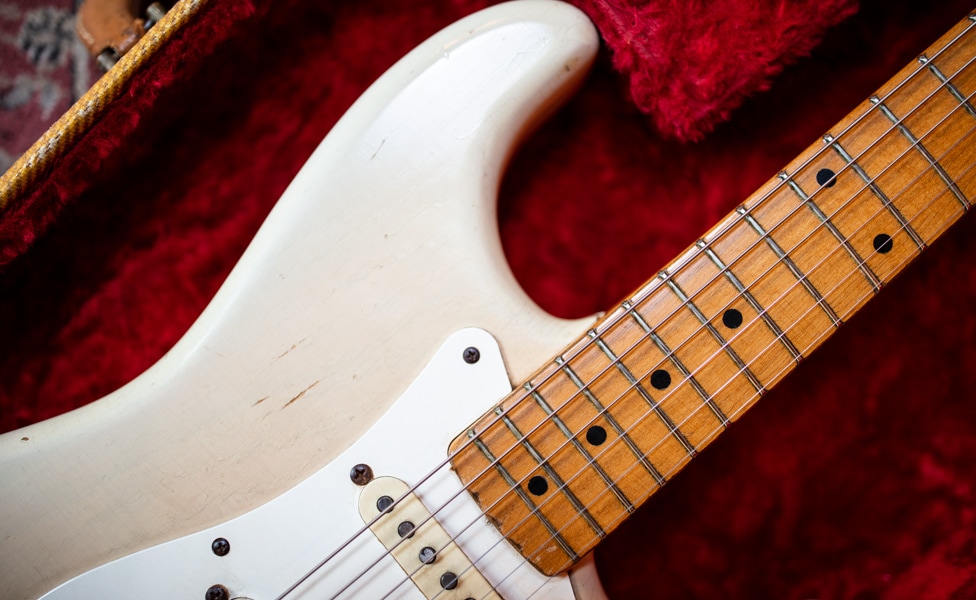
While just about any calendar-year Strat manufactured during the pre-CBS era is considered “collectible,” if you’re looking for other noteworthy options besides the aforementioned 1962 model, there are two viable contenders:
• 1954. Not a surprise. It was the first year of production, and it set the foundation—nailing most of the essential Stratocaster features, even allowing for the refinements to come.
• 1957. The ’57 model is where the neck got really comfy with its strong V shape. And while neck shapes continued to be refined for increased playability in later years, it doesn’t hurt that Eric Clapton’s illustrious “Blackie” Stratocaster had a 1957 neck.
Find Vintage Fender Strats at Guitar Center
Current Fender collections such as the Vintera II “Best of the Decades” models and American Vintage II (which focuses on specific years) can get you extremely close to the feel and sound of vintage Stratocasters—and at “non-vintage” prices. But if you really want to experience an authentic vintage instrument—with all of the history, songs, sounds and road stories within—you’ll need to discover an old-soul Strat.
However, you don’t need to scour auction houses, posh vintage stores and estate sales (hoping a cherry 1954 Stratocaster is lumped in with a cache of collectible Hummel figurines) to find a pre-CBS or later guitar that speaks to you. You can seek your ideal vintage Strat at Guitar Center.
Our Vintage Stratocaster Collection includes models from the ’50s, ’60s, ’70s, ’80s and ’90s, and half the fun is scanning the for-sale items regularly to find a treasure when it becomes available. You never know when something “vintage wonderful” will walk through the door at one of our Guitar Center stores and find its way to our collection. After all, blues-rock ace and guitar collector Joe Bonamassa knows the drill. He has purchased a number of his favorite vintage guitars at Guitar Center. Why not join him and find your dream?
How Leo Fender Got It Right With the Stratocaster
Leo Fender unleashed a string of mammoth, world-changing “hits” that would make Beyoncé envious. From the Telecaster’s birth in 1951, through various Fender amps and basses that became the standards in their class, to the Stratocaster, Leo seemed to have some kind of crazy prophetic power to see into the future of electric music—and he couldn’t play a song or even tune a guitar.
But the man could sure “read the room.”
“In 1952, I could see music was changing,” Fender told journalist Joelle Steele in 1977. “There was a growing demand for greater volume and a faster neck.”
From that foresight, came the machine that has inspired players of all styles, from blues to metal, punk rock to classic rock, funk to jazz and beyond. And let’s never forget that the guitarist who broke artistic barriers and changed rock guitar for everyone in the late ’60s—a sonic sorcerer named Jimi Hendrix—choose the Stratocaster to give voice to the music in his head.
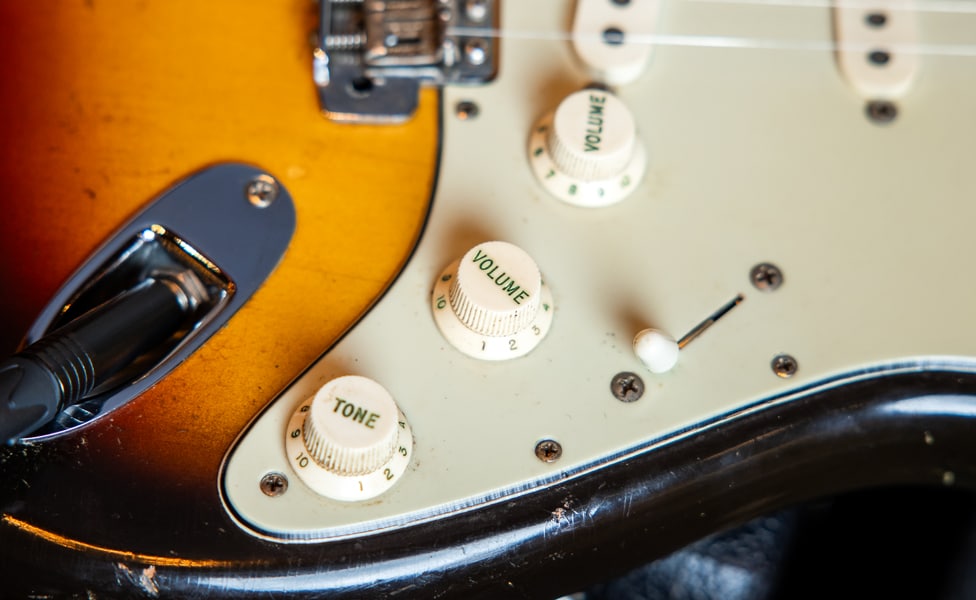
But far from a relic of the 1960s, the ever-evolving Stratocaster made quite the scene at the Super Bowl halftime show on February 11, 2024, when H.E.R. rocked her red, chrome-glow signature model. The Stratocaster is a guitar for the ages, because it doesn’t age.
While other Fender team members certainly contributed to the Stratocaster, and deserve recognition for all that it has become, we can thank Leo Fender above all others for his timeless vision. In fact, when Guitar Player editor emeritus Tom Wheeler was compiling his The Stratocaster Chronicles book, he asked Fender designer/engineer Freddie Tavares straight out whether the Strat was “essentially” a Leo Fender design.
“Without hesitation,” Tavares answered without a second’s pause, “all of the guitars were essentially Leo’s design.”


